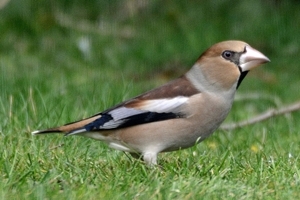Hawfinch
 The hawfinch (Coccothraustes coccothraustes) is the UK’s largest finch, but it is also the most elusive! However, this might be your best chance to catch up with them, as there are many more than usual over-wintering here. This explosion of hawfinch may be due to food shortages on the continent, but it is perhaps more likely that they were blown off course during seasonal movements, landing up over here by chance.
The hawfinch (Coccothraustes coccothraustes) is the UK’s largest finch, but it is also the most elusive! However, this might be your best chance to catch up with them, as there are many more than usual over-wintering here. This explosion of hawfinch may be due to food shortages on the continent, but it is perhaps more likely that they were blown off course during seasonal movements, landing up over here by chance.
Indeed, I had been lucky enough to catch up with a small flock of five in Hampshire while out doing a bird survey in December, and then unbelievably I had a single bird feeding under seed feeders in my garden in Wiltshire – see the attached photo! Hence, I thought I would make it the species of the month.
Hawfinch are primarily seed eaters during the winter months, specialising in large seeds that other birds might struggle with. Hornbeam and cherry are two particular favourites, although they will consume a wide range of other food sources such as beech mast, ash keys and elm seeds, whilst also taking yew, hawthorn and blackthorn sloes.
The most striking thing about seeing a hawfinch is its enormous, out-of-proportion beak that it has, when compared to the rest of its body size! This incredibly powerful beak can exert a tremendous pressure of around 4kg per square centimetre (57 pounds per square inch), enabling it to crush a cherry stone to extract the kernel. The hawfinch’s scientific name of Coccothraustes, meaning “kernel-crusher”, is therefore well chosen!
Although not much longer than a greenfinch, because of this heavy duty bill and associated thick neck, hawfinch appear as large, bulky birds. Their plumage covers a range of attractive autumnal colours, ranging through soft pinks, buffs, glossy blue-blacks, greys and a mix of browns, all finished off with a distinctive black bib directly under the bill.
It is often the contact call of a sharp, loud “tick”, not unlike that of a robin’s alarm call, that raises one’s awareness of this elusive bird.
During the summer, the breeding population in this country is estimated to be only in the region of 500 to 1,000 pairs. The four main strongholds are the Forest of Dean/Wye Valley, New Forest, North Wales and Cumbria.
They build a rather untidy nest of twigs, grass and lichens in which the light blue eggs with black markings are laid. The choice of nest site is often in a remarkably open position in a fork of a woodland tree or fruit tree. This makes them incredibly vulnerable to nest predation from a range of egg- and chick-eating predators such as the grey squirrel, the corvid family (particularly jays) and also woodland raptors such as sparrowhawk and goshawk.
It may well be that the lack of woodland management in this country makes for a less diverse habitat range, leaving nests even more exposed than they might usually be. Also, under-managed woods without an understorey of shrubs perhaps limit insect numbers too, which are vitally important as a chick food source. When combined with a general increase in predator numbers across the country, this may well explain why this superb finch is on the decline.
So, don’t miss out on this opportunity to see these spectacular birds during the next month or so, before they return to the continent. Find yourself a good stand of mature hornbeam trees and sit and wait. You will be enchanted by them if your luck is in!
Peter Thompson
Advisory
Read more from Peter Thompson at his blog.

Download Peter Thompson's essential 26-page book, featuring beautiful photography and detailed profiles of Britain's wildlife
Download FREE >